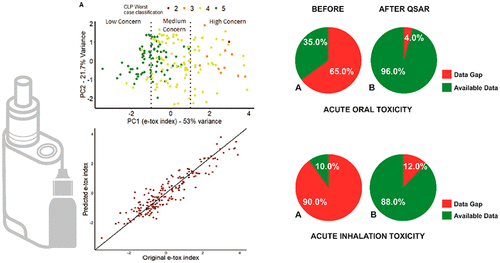当前位置:
X-MOL 学术
›
Chem. Res. Toxicol.
›
论文详情
Our official English website, www.x-mol.net, welcomes your feedback! (Note: you will need to create a separate account there.)
Are In Silico Approaches Applicable As a First Step for the Prediction of e-Liquid Toxicity in e-Cigarettes?
Chemical Research in Toxicology ( IF 4.1 ) Pub Date : 2020-08-11 , DOI: 10.1021/acs.chemrestox.0c00136 Daniele Zarini 1 , Alessandro Sangion 2, 3 , Emanuele Ferri 1 , Enrico Caruso 4 , Sara Zucchi 1 , Alessandro Orro 5 , Ester Papa 3
Chemical Research in Toxicology ( IF 4.1 ) Pub Date : 2020-08-11 , DOI: 10.1021/acs.chemrestox.0c00136 Daniele Zarini 1 , Alessandro Sangion 2, 3 , Emanuele Ferri 1 , Enrico Caruso 4 , Sara Zucchi 1 , Alessandro Orro 5 , Ester Papa 3
Affiliation

|
Recent studies have raised concerns about e-cigarette liquid inhalation toxicity by reporting the presence of chemicals with European Union CLP toxicity classification. In this scenario, the regulatory context is still developing and is not yet up to date with vaping current reality. Due to the paucity of toxicological studies, robust data regarding which components in e-liquids exhibit potential toxicities, are still inconsistent. In this study we applied computational methods for estimating the toxicity of poorly studied chemicals as a useful tool for predicting the acute toxicity of chemicals contained in e-liquids. The purpose of this study was 3-fold: (a) to provide a lower tier assessment of the potential health concerns associated with e-liquid ingredients, (b) to prioritize e-liquid ingredients by calculating the e-tox index, and (c) to estimate acute toxicity of e-liquid mixtures. QSAR models were generated using QSARINS software to fill the acute toxicity data gap of 264 e-liquid ingredients. As a second step, the potential acute toxicity of e-liquids mixtures was evaluated. Our preliminary data suggest that a computational approach may serve as a roadmap to enable regulatory bodies to better regulate e-liquid composition and to contribute to consumer health protection.
中文翻译:

计算机方法是否适用于预测电子烟中电子液体毒性的第一步?
最近的研究报告了欧盟 CLP 毒性分类中化学品的存在,引起了人们对电子烟液体吸入毒性的担忧。在这种情况下,监管环境仍在发展,尚未跟上电子烟的当前现实。由于毒理学研究的缺乏,关于电子液体中哪些成分表现出潜在毒性的可靠数据仍然不一致。在这项研究中,我们应用计算方法来估计研究不足的化学品的毒性,作为预测电子液体中所含化学品急性毒性的有用工具。本研究的目的有 3 个:(a) 对与电子烟油成分相关的潜在健康问题进行较低级别的评估,(b) 通过计算电子毒物指数来优先考虑电子烟油成分,(c) 估计电子液体混合物的急性毒性。使用QSARINS软件生成QSAR模型,填补了264种烟油成分的急性毒性数据空白。第二步,评估了电子液体混合物的潜在急性毒性。我们的初步数据表明,计算方法可以作为路线图,使监管机构能够更好地监管电子烟油成分并为消费者健康保护做出贡献。
更新日期:2020-09-21
中文翻译:

计算机方法是否适用于预测电子烟中电子液体毒性的第一步?
最近的研究报告了欧盟 CLP 毒性分类中化学品的存在,引起了人们对电子烟液体吸入毒性的担忧。在这种情况下,监管环境仍在发展,尚未跟上电子烟的当前现实。由于毒理学研究的缺乏,关于电子液体中哪些成分表现出潜在毒性的可靠数据仍然不一致。在这项研究中,我们应用计算方法来估计研究不足的化学品的毒性,作为预测电子液体中所含化学品急性毒性的有用工具。本研究的目的有 3 个:(a) 对与电子烟油成分相关的潜在健康问题进行较低级别的评估,(b) 通过计算电子毒物指数来优先考虑电子烟油成分,(c) 估计电子液体混合物的急性毒性。使用QSARINS软件生成QSAR模型,填补了264种烟油成分的急性毒性数据空白。第二步,评估了电子液体混合物的潜在急性毒性。我们的初步数据表明,计算方法可以作为路线图,使监管机构能够更好地监管电子烟油成分并为消费者健康保护做出贡献。



























 京公网安备 11010802027423号
京公网安备 11010802027423号